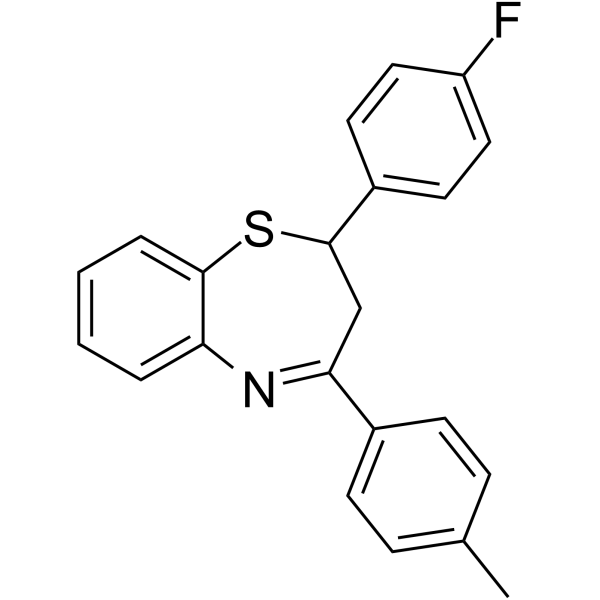α-Glucosidase-IN-16
Modify Date: 2024-01-16 19:53:06

α-Glucosidase-IN-16 structure
|
Common Name | α-Glucosidase-IN-16 | ||
|---|---|---|---|---|
| CAS Number | 1606142-34-0 | Molecular Weight | 347.45 | |
| Density | N/A | Boiling Point | N/A | |
| Molecular Formula | C22H18FNS | Melting Point | N/A | |
| MSDS | N/A | Flash Point | N/A | |
Use of α-Glucosidase-IN-16α-Glucosidase-IN-16 is a potent and orally active α-glucosidase inhibitor with an IC50 value of 3.28 μM. α-Glucosidase-IN-16 can reduce the level of blood glucose in Streptozotocin-induced diabetic rats. Antidiabetic activity[1]. |
| Name | α-Glucosidase-IN-16 |
|---|
| Description | α-Glucosidase-IN-16 is a potent and orally active α-glucosidase inhibitor with an IC50 value of 3.28 μM. α-Glucosidase-IN-16 can reduce the level of blood glucose in Streptozotocin-induced diabetic rats. Antidiabetic activity[1]. |
|---|---|
| Related Catalog | |
| Target |
IC50: 3.28 μM (α-Glucosidase)[1] |
| In Vivo | α-Glucosidase-IN-16 (compound 13B) (10 and 20 mg/kg; PO; once daily for 28 days) significantly reduces the level of blood glucose in diabetic rats[1]. α-Glucosidase-IN-16 (2000 mg/kg; PO; single dosage) exhibits no toxic effects in mice[1]. α-Glucosidase-IN-16 (10 and 20 mg/kg; PO; single dosage) significantly reduces serum glucose level after glucose administration in rats[1]. Animal Model: Wistar rats (170-200 g, 8-10 weeks; induced diabetes by intraperitoneal injection of Streptozotocin (HY-13753))[1] Dosage: 10 and 20 mg/kg Administration: PO; once daily for 28 days Result: Caused a significant reduction in the level of blood glucose compared to diabetic control. Lowered the total cholesterol level. Effect of α-Glucosidase-IN-16 on blood glucose (mg/dL) in Streptozotocin-induced diabetes[1]. dose (mg/kg) day 1 day 7 day 14 day 21 day 28 10 370.81 ± 4.79 289.89 ± 4.33 200.33 ± 4.57 149.30 ± 4.56 132.98 ± 4.33 20 375.31 ± 5.01 230.71 ± 4.88 163.68 ± 4.37 120.72 ± 4.11 108.42 ± 3.98 Animal Model: Balb/C mice[1] Dosage: 2000 mg/kg Administration: PO; single dosage (acute toxicity study) Result: Exhibited no toxic effects (via observing signs of diarrhea, convulsions, lethargy, sleeping, salivation, and tremor). Animal Model: Wistar rats (oral administration with 3 g/kg glucose)[1] Dosage: 10 and 20 mg/kg Administration: PO; single dosage (oral glucose tolerance test) Result: Significantly reduced serum glucose level (110-113 mg/dL) compared to the control group (128 mg/dL) after 2 hours of glucose administration. |
| References |
| Molecular Formula | C22H18FNS |
|---|---|
| Molecular Weight | 347.45 |